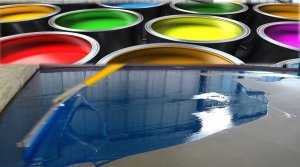Unlike maintaining an ordinary floor, it is tough to maintain the floor of your swimming pool. Finding a perfect solution to make you flooring great in looks as well as weathering away due to constant contact with water is indeed a challenge but not entirely impossible. You could confidently say so because you can give your pool that is looking old and ill-maintained an all-new look and maintain it that way for years to come using the epoxy pool paint. It is quite cheaper than revamping the pool floor with pool tiles and much easier to maintain it too.
Painted pools- problems you may encounter
The problems you face with painted pool includes
Fading or staining – This is a natural process that happens over time. You cannot prevent even the brightest paint from looking dull as time passes. Acid wash might be a remedy that may help you clean the dirt and chalking, but it would dull the paint too.
Chalking – Paint surfaces have a tendency to break down leaving a white residue that gives the water a hazy look and it is called chalking. To prevent this the alkalinity and the PH must be in balance. When alkalinity, as well as the ph level, are low it leads to chalking or paint deterioration.
Blisters and bubbles- This does not happen with use, but it is a result of improper preparation for pool painting. If there had been moisture content in the in the flooring when it was being painted it would result in blisters. The application temperature may cause the occurrence of blisters.
Epoxy coating
You might know that the swimming pools come with different finishes. You may have the floor of the pool tiled, or you could leave it with a painted concrete flooring, or it could be of fiber. But maintaining a painted concrete flooring is quite tricky and using tiles could be an expensive affair, and it still needs to be maintained too. When you are thinking of revamping your fading, chalking and worn-out pool flooring and giving it a new and radiant look that lasts long even up to 20 years, you have to consider the epoxy swimming pool paint.
What are the features of the Epoxy paint?
The Epoxy is a thermosetting polymer that is made of two parts the hardener and the resins. The epoxy pool paint is a special paint that adheres to the surface of the pool and creates a coating that makes the floor resistant to chemicals, stains, and abrasion. They are specially formulated to remain fresh and new even in submerged conditions. It is the cheapest and perhaps the long-lasting solution for your swimming pool. It gives the pool a high-gloss finish. The most endearing features of the epoxy coating include
1. Bond strength
2. Protection from UV rays
3. Exceptional penetration
4. Chalk resistance
5. Protection from algae infestation
6. Chemical resistant
7. Glossy finish
8. Cost-effective
9. Suitable for resurfacing and repairing
10. The shorter time required for putting the pool to use which is a maximum of 5 days.
Where can you use an Epoxy coating ?
The epoxy is a perfect solution for pool painting of all types and sizes which includes
1. Spas
2. Decorative ponds
3. Indoor pool
4. Outdoor pools
It is an ideal solution for keeping the pool fresh and ensure its longevity for
1. Resorts
2. Golf courses
3. Recreation areas
4. Parks
5. Apartment complexes
6. Houses
that features a swimming pool for the first time or those thinking of swimming pool repair.
Why should you Use Epoxy paints?
Life Expectancy
There are many Epoxy paints in the market. There are high-build epoxy paints that offer a life expectancy of up to 20 years while the minimum life you can expect with the epoxy coating is about eight years. The coating is an ideal for concrete, gunite, fiberglass or plaster that feature a tile-like finish. With the glossy finish and qualities that outlast other chlorinated rubber coatings which render it a “One Time Investment” that guarantees all-new look throughout its life.
The color choice
There are a number of eye-catching epoxy pool paint colors to choose from. It includes
1. White
2. Light Blue
3. Medium blue
4. Coral Blue
5. Night Blue
6. Aqua
7. Royal blue
8. Charcoal
9. Black.
However, the color choices are dependent on the brand of epoxy pain you choose to use for your pool. If you select the best brands with silicone and UV stabilizers, you can be assured of color retention and protection from UV rays and chlorine for a long time.
Impervious finish
The Epoxy Coating does not only lend a great glossy appearance, but it also makes the pool flooring protection from deterioration due to chemicals, abrasion, algae, pool cleaning machines, mineral oils, fresh or salt water and others. This is achieved by the impervious finish that the epoxy coating provides with pool renovation.
Fill qualities
The feature that makes an epoxy pool paint cost-effective apart from the life expectancy is its fill qualities. The Epoxy paint that is required to coat a properly prepared surface is comparatively lesser than any other type of paint coating. You also get the advantage of getting a smooth and hard finish even if the pool surface is imperfect which means additional savings on plastering costs.
Shorter waiting time.
The Epoxy paint drys fast and makes it possible for you to use the pool as early as possible. In general, the first coating of the paint takes about 6-8 hours to dry at 75 degrees Fahrenheit. This time reduces drastically in case of higher temperature and lower humidity. This could be followed by an optional second coat to be applied within 16-72 hours. Now the pool is ready. You need to let it cure for 5 days after which you can fill it water. In case there is rain, it is important to add one day more to each day of rain before you fill water in the pool after the swimming pool repair.
Applying Epoxy Paint
The process of application consists of three steps
1. Estimating the paint requirements
2. Surface preparation
3. Mixing and application
The paint requirements
There might be slight differences in the estimation of paint required depending on the quality of the epoxy paint, the general rule is to estimate coverage using the following formula Length of the pool Xwidth of the pool X1.7 = square footage. The square footage should be multiplied by 2 (if you want two coats) and then divided by 500 to get the epoxy requirements. You have epoxy kits starting from 2 gallons. The requirement calculation will give you a fair idea of the number of kits you require for pool renovation.
Surface preparation
1. Use water blasting to remove paint, dirt, grease, and oil from the surface of the pool
2. Use Trisodium Phosphate (TSP) wash to scrub the surface
3. Use Muriatic acid solution (15-20%) to etch the surface
4. Rinse thoroughly holy with TSP and fresh water.
5. Dry the pool after pool painting
Mixing and application
Follow the instructions given for the mixing of the epoxy paint. Mix only enough epoxy that you can apply within 1 or 2 hours. Note that high temperatures would reduce the pot life of the paint. The paint can then be applied using the brush and roller or sprayed. Rolling is however recommended for the best finish. It dries to give a glossy, finish. You can add pumice stone, marble dust or sand to provide it with an anti-skid finish.
The DIY project
The applying epoxy coating is a simple DIY project if only you know how to go about it. The epoxy is usually sold in the form of an epoxy kit, and you need to buy the number of epoxy swimming pool painting kits you required based on the size and area of the pool as well as the number of coats which you wish to apply. The recommended, as well as the right number for a proper finish, is generally 2.
Differentiating an epoxy from other paints
This is essential to determine the type of paint that has been already applied in the pool. If the paint type is not known to you, you can find it out by sending a sample to a paint manufacturer or by testing it.
The test
1. Immerse one-inch paint chip in denatured alcohol, the paint is a water-based acrylic, if the chip dissolves
2. Immerse a chip in 75% mineral spirits and xylol 25%leave it for 30 secs. Now rub the chip between your fingers, if it dissolves, you may conclude that the paint is Synthetic rubber base coating
3. Immerse a chip in 100%xylol. If the chip dissolves, then it is a chlorinated rubber.
4. If it does not dissolve in 100%Xylol, it is an epoxy pool paint.
Factors to consider while using Epoxy
5. It is best to apply epoxy paint at surface temperatures of 50-90 degree Fahrenheit to get the best coverage rate.
6. While the drying period is five days in case there is no rain, it is better to have a waiting period of 10-12 days in case of indoor pools
7. When you are recoating, do it within 72 hours. If you are recoating it after 72 hours, you should do it by sanding the first coat.
8. No primer is required for epoxy paints
9. The pot life of mixed epoxy pool paint is only three hours, and the shelf life of the epoxy mix is only a year. Take care while mixing and buying.
10. Get ready to give your pool an all-new fresh look that lasts long to consider it an one- time investment.
